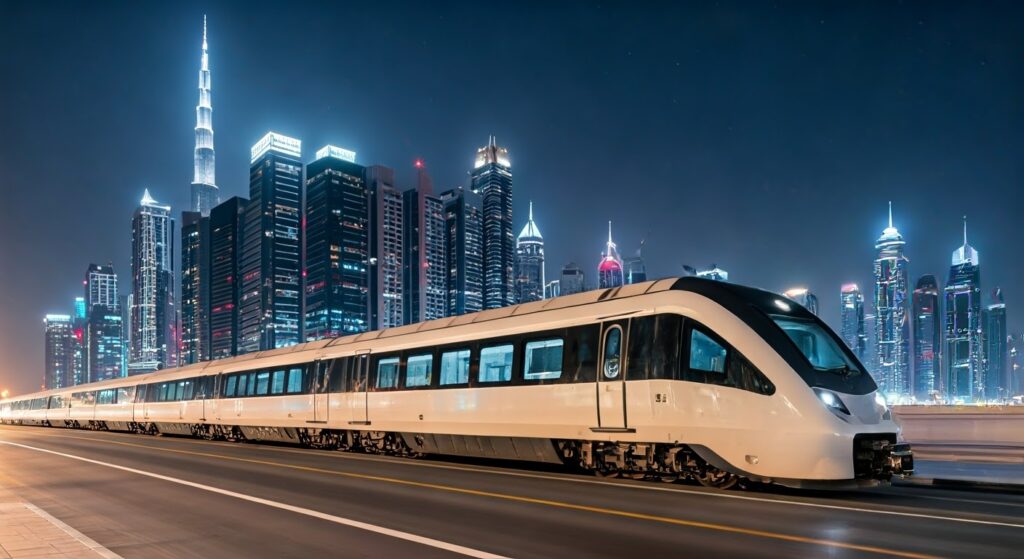The upcoming launch of Eithad rail UAE change how people live and work across the UAE. This major infrastructure project promises to make distant areas more accessible, which will affect property prices and rental demand. Real estate experts predict significant changes in how people choose where to live based on improved transport connections between cities. Also look for Dubai Airport Issues Essential Travel Warning if you’re Travelling Today
-
From Remote to Connected – Major Changes Coming
The Etihad rail in UAE will transform areas that people once considered too far from major employment centers. Cities like Ras Al Khaimah, Fujairah, and emerging communities in Abu Dhabi and Sharjah will see increased demand for both new and existing homes.
Mark Castley, CEO of Real Estate at Huspy, explains that large infrastructure projects like this typically boost real estate growth in surrounding areas by improving accessibility and creating new demand. Areas that seemed distant due to traffic or long commute times will become attractive options for residents seeking larger homes and better value.
Important Details:
- Operations start: 2026
- Expected passengers: 36.5 million annually by 2030
- Railway length: 900 kilometers
- Cities connected: 11 cities across all seven emirates
- Published: Friday, August 22, 2025, 6:00 AM
- Author: Waheed Abbas
-
Tier-2 Cities Rising to New Status
Firas Al Msaddi, CEO of fäm Properties, notes that land values in Tier-2 cities will face upward pricing pressure from organic demand rather than speculation. Eithad rail UAE 2025 will create transit-oriented developments near confirmed station zones.
These developments will feature walkable mixed-use clusters around stations. The improved connectivity means a family might live in Dubai but own a weekend beach property in Fujairah and actually use it regularly because the journey takes less than an hour.
Dubai will remain dominant, but the edges of its influence will expand significantly. Each emirate has unique offerings, but until now, the time cost of movement for people, goods, and capital has been too high.
Important Details:
- Target cities: Fujairah, Al Dhaid, Ruwais
- Station locations: University City, Sakamkam, Mussafah
- Travel time reduction: From 2 hours to 50 minutes between cities
- Key corridor: Jumeirah Golf Estates station
-
Complete Geographic Transformation
The rail system creates complete re-pricing of land value based on accessibility rather than just geographic location. 2025 Eithad rail in UAE represents more than just transportation – it involves speed, interconnectivity, and productivity improvements that compress space and time.
When space and time get compressed, opportunity costs decrease, which unlocks real value for investors and residents. What used to be considered “too far” suddenly becomes next door to major employment and entertainment centers.
Fujairah transforms from the UAE’s endpoint into the Eastern gateway. Ras Al Khaimah becomes accessible for Dubai families seeking weekend retreats. Al Ain offers realistic housing for remote professionals who can reach the capital or coast within an hour.
Important Details:
- Fujairah positioning: Eastern gateway instead of endpoint
- Ras Al Khaimah: Viable weekend market for Dubai families
- Al Ain: Realistic base for remote professionals
- Access time: Under one hour to capital or coast
-
Learning from International Success Stories
Historical examples show the transformative power of high-speed rail connections. The Tokyo-Osaka line transformed satellite cities within five years of full operation. Nagoya evolved from a second-tier market to one of Japan’s most competitive logistics and office markets.
This transformation happened not because people loved trains, but because business travel, tourism, and hybrid commuting unlocked economic flow that was previously restricted by time constraints.
Important Details:
- Case study: Tokyo-Osaka Shinkansen Line, Japan
- Results within 5 years: 40% increase in commercial land values
- Housing demand: 60% increase in population-linked demand
- Nagoya transformation: Second-tier to competitive logistics and office market
-
Second-Home Market Revolution
The rail network will redefine second-home markets across the UAE. Families can maintain primary residences in business centers while owning weekend retreats in scenic locations that become practically accessible.
This shift creates genuine demand for properties in previously remote areas. Investment opportunities emerge from practical usage rather than speculation, leading to more stable property value increases.
Important Details:
- New market opportunities: Weekend properties in coastal areas
- Accessibility factor: Properties become viable due to reduced travel time
- Investment potential: Organic demand rather than speculative buying
Conclusion
The Eithad rail UAE represents a complete transformation of the UAE property landscape. Areas once considered too distant from major employment centers will become viable residential options due to dramatically reduced travel times. This infrastructure project will create new property investment opportunities, reshape commuting patterns, and establish integrated communities around major stations. Property buyers and investors should consider accessibility to planned rail stations when making decisions, as these connections will determine future property values and rental demand across the emirates.






